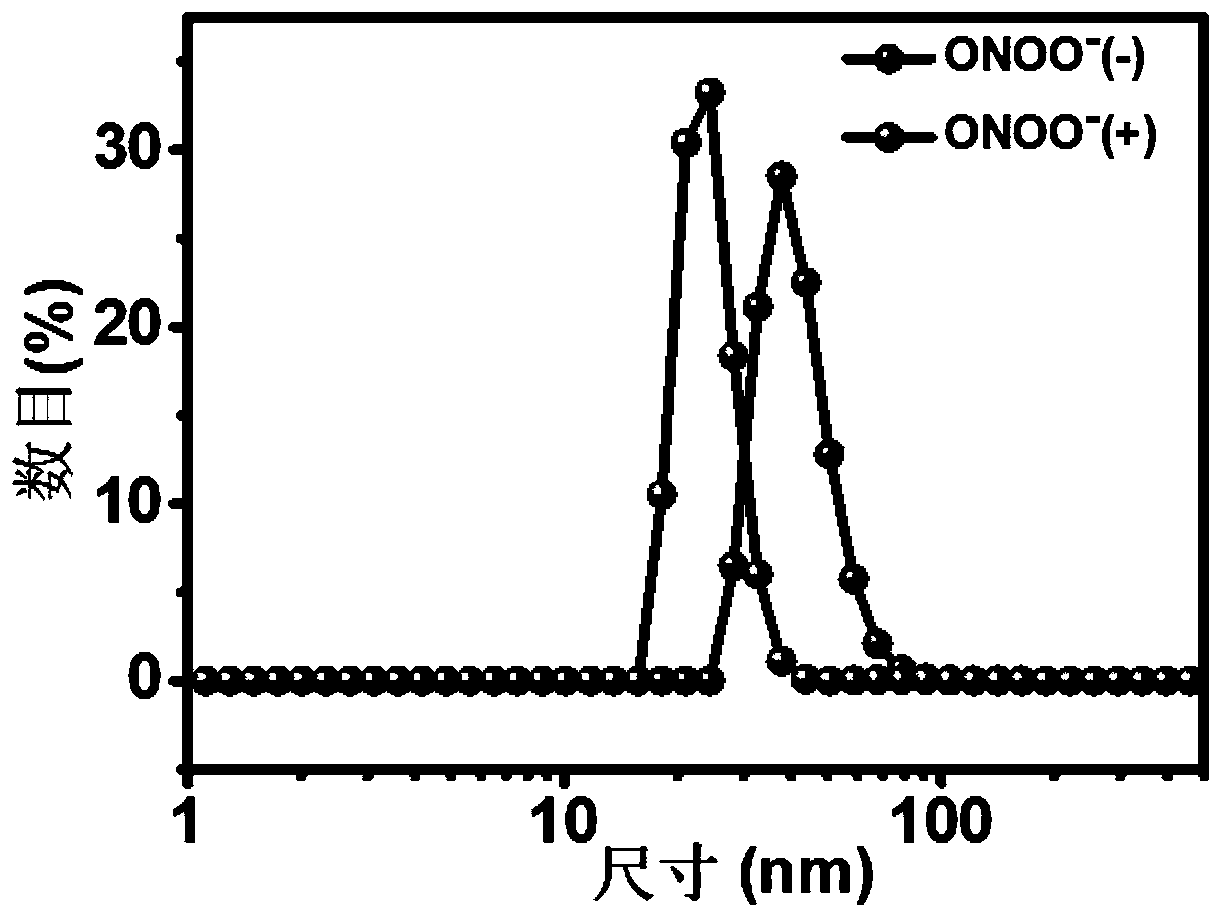Prussian blue-based nanoprobe and preparation method and application thereof
A nanoprobe, Prussian blue technology, applied in the field of biosensors, can solve the problem of lack of ONOO-selectivity, and achieve the effect of improving poor penetration depth, no detection and imaging, and high sensitivity
- Summary
- Abstract
- Description
- Claims
- Application Information
AI Technical Summary
Problems solved by technology
Method used
Image
Examples
Embodiment 1
[0059] Embodiment 1 Preparation of simple PB nanoprobe:
[0060] 5mL containing K 4 [Fe(CN) 6 ] (1mM) of citric acid solution (30mM) was slowly added to 5mL containing FeCl 3 (1 mM) in HCl solution (25 mM); at room temperature, and then vigorously stirred for 60 minutes; then, the obtained PB nanoparticles were centrifuged and washed 3 times with ultrapure water to remove excess unreacted ions, and stored in 4°C.
[0061] figure 2 Be the transmission electron microscope figure of embodiment 1 gained PB, from figure 2 It can be seen that the particle size of the synthesized PB is about 35nm.
Embodiment 2
[0062] Example 2 PB detects ONOO - proficiency testing
[0063] Using the PB obtained in Example 1, quickly 10 μL of different concentrations of ONOO - Solutions (eg 0, 40, 80, 120, 160 and 200 μM) were added to 190 μL of PBS (pH=7.4) containing PB solution;
[0064] The final concentration of PB was 3.8 μg / mL, which was tested after 10 minutes by UV-Vis absorption; and ONOO was selected - Two samples at concentrations of 0 and 200 μM were tested for particle size change by DLS.
[0065] Additionally, using ONOO - Donor 5-amino-3-(4-morpholinyl)-1,2,3-oxadiazole hydrochloride (SIN-1) confirmed that the response of PB was indeed caused by ONOO - caused by other substances in the reaction system. After incubation of PB with SIN-1 in PBS (0.1 mg / mL, pH=7.4) for 5 hours, the uptake of SIN-1-treated PB (3 μg / mL) was greatly reduced compared to untreated PB.
[0066] image 3 Detect ONOO for PB - The change in particle size after DLS, from image 3 It can be seen that the s...
Embodiment 3
[0070] Example 3PB detects ONOO by photoacoustic imaging - proficiency testing
[0071] Using the PB obtained in Example 1, quickly add 20 μL of different concentrations of ONOO - Solutions (eg 0, 40, 80, 120, 160 and 200 μM) were added to 380 μL of PBS (pH=7.4) containing PB solution. The final concentration of PB was 9.5 μg / mL, and photoacoustic imaging was performed 10 min later.
[0072] Figure 6 Detection of ONOO for PB photoacoustics - proficiency testing from Figure 6 It can be seen that the photoacoustic signal of PB in the near-infrared region increases with the ONOO - decrease with increasing concentration.
[0073] Figure 7 Detection of ONOO for PB photoacoustics - Photoacoustic signal at 710nm and ONOO - The relationship between concentrations, from Figure 7 It can be seen that PB detects ONOO - , the photoacoustic signal at 710nm and ONOO - Concentrations are negatively correlated.
[0074] Analysis: Thanks to ONOO -The near-infrared absorption o...
PUM
| Property | Measurement | Unit |
|---|---|---|
| Particle size | aaaaa | aaaaa |
| Particle size | aaaaa | aaaaa |
| Particle size | aaaaa | aaaaa |
Abstract
Description
Claims
Application Information
 Login to View More
Login to View More - R&D
- Intellectual Property
- Life Sciences
- Materials
- Tech Scout
- Unparalleled Data Quality
- Higher Quality Content
- 60% Fewer Hallucinations
Browse by: Latest US Patents, China's latest patents, Technical Efficacy Thesaurus, Application Domain, Technology Topic, Popular Technical Reports.
© 2025 PatSnap. All rights reserved.Legal|Privacy policy|Modern Slavery Act Transparency Statement|Sitemap|About US| Contact US: help@patsnap.com



